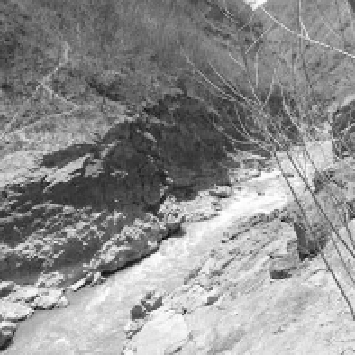Environmental Engineering Reference
In-Depth Information
transported in the river. Particles slid or jumped over the bedrock channel and hit against the bedrock,
which cause the bedrock corrasion.
Cavitation occurs when velocity fluctuations in a flow induce pressure fluctuations that cause the
formation and implosion of vapor bubbles. The shock waves generated by implosion can weaken
bedrock and pit the rock surface. Under sustained high flows, the erosive potential of this process can be
phenomenal. During 1983, discharges up to 900 m
3
s
-1
through the spillway at Glen Canyon Dam on the
Colorado River, U.S., generated cavitation that within days eroded pools up to 10 m deep and 6 m long in
a stair step configuration down the 12.5 m diameter concrete-lined spillway (Eckley and Hinchliff, 1986).
Corrosion, corrasion and cavitation may occur simultaneously in the process of bedrock channel
incision. In most cases remarkably little is known about the actual processes by which bedrock channels
are eroded. Quantitative experimental studies using both cohesive silt and clay substrates in flumes, and
actual rock and sediment for estimating abrasion rates, would be extremely useful.
(a)
(b) (c)
Fig. 3.17
The bedrock channel of the Lijiang River is eroded by corrasion induced by gravel movement on the bed;
(b) Bedrock channel of a tributary of the Jinsha River has been incised down by about 20 m mainly due to corrasion;
(c) Parallel corrasion slots on bedrock of the Jinsha River (See color figure at the end of this topic)
The surface of bedrock channel can be rough, which creates high resistance and consume the flow
energy. Figure 3.18 shows the rough bed of the Black River in Shaanxi. The bedrocks are scoured into a
bedrock step-pool system. The high resistance of bedrock structure controls the bed incision and
stabilizes the channel bed. A section of such bedrock channel becomes a knickpoint of the river.





Search WWH ::

Custom Search